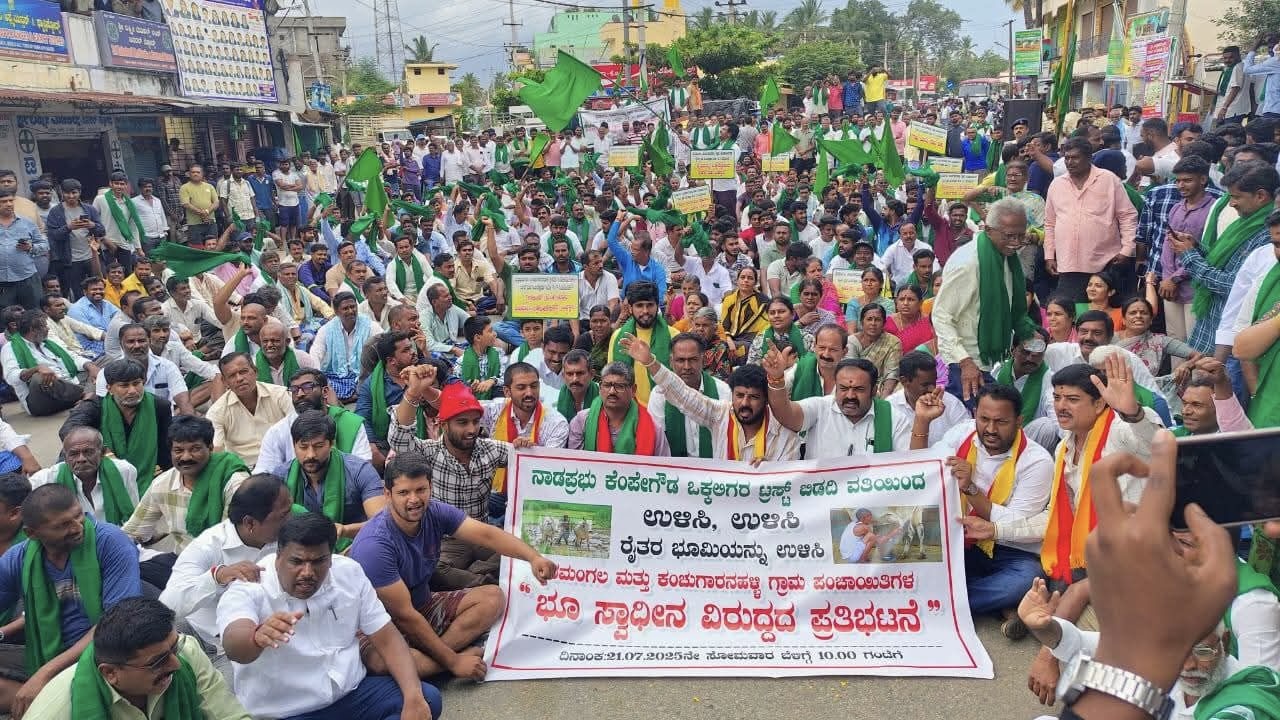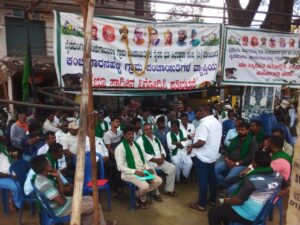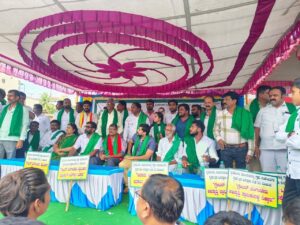First proposed in 2006 under the HD Kumaraswamy-led Janata Dal (Secular)-Bharatiya Janata Party government, the state cabinet approved the rebranded project in February 2025. Rebranded as India’s first AI-powered "work-live-play" city, the project envisions a “second central business district” spanning 9,000 acres, about 30 km from the city centre.
Published Oct 03, 2025 | 9:00 AM ⚊ Updated Oct 03, 2025 | 9:00 AM

The JD(S), positioning itself as a party working for farmers’ interests, has joined the indefinite protest.
Synopsis: Farmers from 26 villages near Bidadi town in Ramanagara taluk have been protesting for over 200 days against the Karnataka government’s 9,000-acre Greater Bengaluru Integrated Township project, citing forced acquisition of fertile farmland and alleged violations of the Land Acquisition, Rehabilitation and Resettlement Act. The project, first proposed in 2006 and rebranded as India’s first AI-powered “work-live-play” city, aims to decongest Bengaluru and develop over 2,000 acres for AI-based industries, but farmers argue it threatens livelihoods, dairy farming, and sericulture in the region.
Months after a 1,198-day agitation by farmers in Karnataka’s Devanhalli in Bengaluru Rural district forced the Congress-led state government to drop a plan to acquire 1,777 acres of fertile farmland for an aerospace park, another protest has gained momentum in Bengaluru South district.
For the past 200 days, farmers from 26 villages in Byramangala and Kanchugaranahalli gram panchayats, near Bidadi town in Ramanagara taluk, have been on an indefinite protest against the Siddaramaiah government’s decision to proceed with the Greater Bengaluru Integrated Township (GBIT) project.
Though first proposed in 2006 under the HD Kumaraswamy-led Janata Dal (Secular) [JDS(S)]-Bharatiya Janata Party (BJP) government, the state cabinet approved the rebranded project in February 2025. It is now being championed by Bengaluru Urban district in-charge minister and Deputy Chief Minister DK Shivakumar.
Rebranded as India’s first AI-powered “work-live-play” city, the project envisions a “second central business district” spanning 9,000 acres, about 30 km from the city centre.
More than 2,000 acres are earmarked for AI-based industries and related units, while the rest is being promoted as a way to “decongest Bengaluru.”
Preliminary notifications for land acquisition were issued in 2006 when the project was first mooted. Farmers say strong opposition at the time forced the government to stall the plan.

The state has largely promised a 50:50 compensatory model, under which farmers who give up their land are promised developed plots.(Supplied)
“But the current Congress government has issued final notifications for this project without hearing the grievances of farmers in the region. The land being acquired for this project is fully fertile and irrigated throughout the year. They are forcefully acquiring this land,” said Yashavantha, general secretary of the Karnataka Prantha Raitha Sangha (KPRS).
Farmers argue that issuing final notifications nearly two decades after the preliminary notice violates the Land Acquisition, Rehabilitation and Resettlement Act, 2013 (LARR Act).
Under the LARR Act, the final acquisition notification must be published within 12 months of the preliminary notice. If it is not issued within this period, the preliminary notice is deemed revoked.
Although the project was proposed in 2006, it gained momentum only in 2023, after the Greater Bengaluru Bidadi Smart City Planning Authority was upgraded to the Greater Bengaluru Development Authority (GBDA).
As the implementing agency, the GBDA issued fresh preliminary notices to farmers in March 2025. Farmers contend that since nearly two decades have passed without the land being utilised, it should have been de-notified.
“It has been almost 20 years since the preliminary notification was issued. The government is bypassing land acquisition rules,” said Yashavantha.
In September, Shivakumar said that as many as 70 percent of landowners were in favour of the acquisition. Farmers, however, rejected this claim.
Prakash, one of the protesting farmers from Bidadi, told South First that the region is known for dairy farming and sericulture.
“We are a major source of raw milk for Bengaluru. The region is also surrounded by rivers which gives us a good supply of water. Over 90 percent of the land being acquired is fertile farmland which provides us with good profits,” he said.
Over 2,700 applications clearly stating farmers’ opposition to the project have been submitted to the government, said Yashavantha.
“Not a single farmer has been consulted so far. How can he (Deputy CM) make such a statement?” he asked.
Farmers also see the project as part of a larger push to expand industrialisation. A host of manufacturing companies, including Coca-Cola, Toyota, and Bosch, have set up factories in the Bidadi industrial area, which borders the land currently notified for acquisition.

Shivakumar said that as many as 70 percent of landowners were in favour of the acquisition. Farmers, however, rejected this claim.(Supplied)
The district was also short-listed as a potential site for Bengaluru’s second airport, fuelling further unease among farmers. Shekhar, another protesting farmer, highlighted the threat these projects pose to the thriving dairy economy.
“We provide six lakh litres of milk to the KMF [Karnataka Milk Federation] monthly. We end up getting good business. While these industrial projects promise jobs for locals, we know from recent experiences that it is never the case,” he said, adding that every new project chips away at their farmland and livelihoods.
In leaflets distributed to farmers about the proposed plan, the state has largely promised a 50:50 compensatory model, under which farmers who give up their land are promised developed plots.
The government has also announced that it would provide livelihood support from the date of the final notification until monetary compensation is paid or developed sites are handed over.
Under the plan, landowners will receive annual annuities ranging from ₹30,000 to ₹50,000 per acre, depending on the type of land, while landless families will be given ₹25,000 per year.
For those who prefer cash, the state has offered between ₹1.5 crore and ₹3 crore per acre, depending on the land and road access.
However, farmers are demanding ₹5–6 crore per acre, reflecting the high land prices around Bidadi industrial area—just a few kilometres away—which have continued to skyrocket over the last decade amid booming industrialisation.
The project has also become a political flashpoint between the ruling Congress government and the opposition JD(S), which has significant influence in the district. The JD(S), positioning itself as a party working for farmers’ interests, has joined the indefinite protest.
“JD(S) is a farmers’ party. We will not allow any injustice to be done to farmers under any circumstances. For what purpose is the government forcibly acquiring farmers’ land without considering the pros and cons of the project? Is it to facilitate the real estate mafia?” asked JD(S) Youth Wing president Nikhil Kumaraswamy on 28 September during a protest in Byramangala village.
In April, former Prime Minister and JD(S) patriarch HD Deve Gowda wrote to Chief Minister Siddaramaiah, warning that the proposed land acquisition could push many rural youth into unemployment.
“Ramanagara’s proximity to Bengaluru has already led to the rapid spread of private industries. The limited agricultural land left is vital for the livelihood of thousands of farmers, most of whom are marginal landholders from economically weaker sections,” he wrote.
He added that farmers have taken up sericulture, dairy, and other activities.
“They have trees and crops on their lands. If land from here is acquired, it will disrupt the rural economy and cause lasting environmental damage,” he wrote.
His son, HD Kumaraswamy, who has previously represented both Ramanagara and Channapatna Assembly seats, has been at loggerheads with Shivakumar, who represents the neighbouring Kanakapura Assembly constituency.
Shivakumar questioned the opposition from JD(S), pointing out that the preliminary notification for acquisition was issued under the Kumaraswamy government.
“It is Kumaraswamy who issued the notification for this project, signed the agreement with DLF for this Bidadi Township, and got paid too. Why was this land not de-notified during his rule? When Yediyurappa gave the land to KIADB, all the farmers in that area received compensation. The land is now under the KIADB. There is no opposition from the farmers,” the Deputy Chief Minister claimed.
He further ruled out any scope of de-notifying the land. Kumaraswamy, in response, criticised Shivakumar for “falsely” accusing the Devegowda family of initiating the project.
“It is deeply disturbing that the person who repeatedly exploited the land of the poor and the farmers is now making frivolous remarks about me. Unlike Shivakumar, who has built schools, colleges, or high-rise complexes on the lands taken away from the poor, I am building a life as a farmer in Bidadi,” Kumaraswamy said.
Shivakumar has recently been criticised for pushing ambitious industrial projects even as existing public infrastructure remains in poor condition.
Meanwhile, farmers caught in the crossfire deny that their protest is politically motivated.
“We protested when BJP-JD(S) was in power. We are continuing to protest under Congress too. We just want justice for farmers,” said Yashavantha.
(Edited by Dese Gowda)
